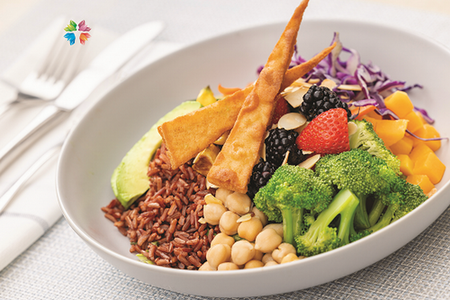



In 2022, with the pandemic still ever-present, how do we reset our lives and once again create a balance?
“There are studies about the amount of anxiety and stress caused by the pandemic,” notes Eisenhower Registered Dietitian Rosalind Elemy, MA, RDN, CSO. “People are emotional eaters and they handle stress by eating. They also have more access to food working from home. Television watching has increased which has also increased the amount of snacking.”
Make a plan but don’t overdo it
According to Elemy, having a plan helps set new habits in motion but she warns about overdoing it.
“Try not to fix everything at once,” suggests Elemy. “Start with one goal. If you find you’re snacking too much and too often, cut back on the amount. Or plan to replace an unhealthy snack with something healthier.
“Setting realistic goals is important. If you fall off the wagon and revert to pandemic snacking and eating, don’t feel like it’s a failure. Just begin again the next day.”
What constitutes a healthy eating plan?
Stocking your kitchen with plenty of fresh fruits and vegetables is a great way to begin a healthy eating regimen. When possible, focus on eating/preparing a plant-based diet, lean protein sources, whole grains and an adequate fluid intake, primarily water.
“Whole grains are important for energy, fiber, vitamins and minerals,” explains Elemy. “People who exclude carbohydrates like whole grains are missing out on B vitamins. It’s best to get nutrients from food rather than supplements.”
And alcohol? According to the American Cancer Society®, if you don’t drink, don’t start. If you do drink alcohol, limit yourself to one drink per day for women and two drinks per day for men.
The plate method of portion control
One easy way to plan meals is using the plate method. Using a 10- to 11-inch plate, fill half with fruits and vegetables. One quarter of the plate should contain a lean protein and the other quarter should have a carbohydrate, such as a half cup (one serving) of brown rice or a combination of grains, such as rice, quinoa and millet. Or throw in some wild rice. Baked or steamed sweet potatoes are another option. A medium-size sweet potato has about 140 calories and five grams of fiber. Dry peas, beans, lentils and chickpeas — as well as other legumes — are excellent sources of carbohydrates. When eating canned beans, rinse thoroughly before adding to whatever you’re cooking.
Healthy Bowls
Read the label
Reading labels is another way to understand portion size and the number of calories you’ll be consuming. Labels also list the amount of sodium and fat, including the type of fat. Look for monounsaturated and polyunsaturated fats. Foods high in good fats include olive oil, nuts, seeds, fish (such as salmon and sardines) and avocados. Saturated fats are generally found in animal products, like red meat. Limit red meats to three times a week maximum. Less is better.
“Regarding portion size, people get in the habit of grazing from a whole can of nuts,” says Elemy. “It’s better to think of nuts as a condiment, something to sprinkle on foods, to add to yogurt, salad or oatmeal. Eat them in small quantities.”
A one-ounce serving of walnuts equals about six walnuts (12 halves) and has 4.3 grams of protein, 18 grams of unsaturated fat and 185 calories. Walnuts contain a large percentage of polyunsaturated fatty acids and are an excellent source of omega-3 fatty acids. Omega-3 fatty acids effectively help reduce triglycerides and are linked to a reduced risk of heart disease.
Almonds provide impressive benefits as a source of fiber and calcium. A one-ounce serving of 23 almonds has 162 calories, 14 grams of monounsaturated and polyunsaturated fatty acids, and 6 grams of protein.
Healthy snacks include apple slices and almond or peanut butter, sliced fresh vegetables with hummus or bean dips, fresh fruit slices or unsweetened yogurt and blueberries, popcorn in limited portions, roasted chickpeas, whole grain crackers and hard cheeses (aged cheddar, Gouda, Swiss and parmesan) in limited amounts, and olives. Create delicious combinations, such as two dates with two walnut halves.
How long does it take to adopt a new habit?
Change one habit at a time. Work on one goal and stay consistent for at least three weeks.
“Set goals that are realistic,” says Elemy. “For example, add an extra serving of fruits and vegetables each day. Or add a healthy snack to your snack list. Eat one plant-based meal each week.”
However you choose to add healthy choices back to your eating and drinking habits, be kind to yourself and those around you. One step, one goal, one day at a time.